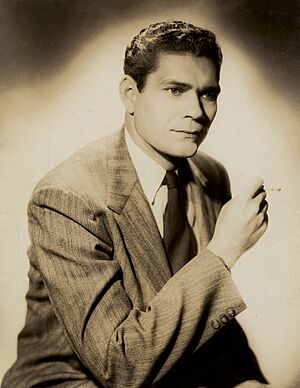Clay Shaw facts for kids
Quick facts for kids
Clay Shaw
|
|
|---|---|
 |
|
| Born |
Clay LaVergne Shaw
March 17, 1913 Kentwood, Louisiana, U.S.
|
| Died | August 15, 1974 (aged 61) New Orleans, Louisiana, U.S.
|
| Education | Warren Easton High School |
| Occupation | Businessman and director of the International Trade Mart in New Orleans |
| Military career | |
| Service/ |
United States Army |
| Years of service | 1941–1946 |
| Rank | Major |
| Battles/wars | World War II |
Clay LaVergne Shaw (born March 17, 1913 – died August 15, 1974) was an American businessman and a former military officer. He is most known for being the only person put on trial for being involved in the assassination of John F. Kennedy. Shaw was found not guilty in 1969.
Contents
About Clay Shaw
Clay Shaw was born in Kentwood, Louisiana. His father, Glaris Lenora Shaw, worked as a United States Marshal. His grandfather was a sheriff in Tangipahoa Parish. When Clay was five years old, his family moved to New Orleans. There, he went to Warren Easton High School.
After finishing high school in 1928, Shaw started working for Western Union. He became a manager in New Orleans. In 1935, he moved to New York City and became a district manager. While in New York, Shaw studied at Columbia University. He wanted to become a writer. Later, he left Western Union to work in public relations. He took a job with the Keedick Lecture Bureau.
Shaw's Military Service
When World War II began, Shaw joined the United States Army. He first worked in the Medical Corps. Later, he became an officer. He served in England in a hospital unit. Then, he moved to the Quartermaster Corps. He worked as a secretary for the General Staff in England. After the D-Day invasion, he served in France and Belgium.
Shaw received several awards for his service. The United States gave him the Legion of Merit and the Bronze Star. France honored him with the Croix de Guerre and named him Chevalier de l'Ordre du Merite. Belgium named him a Knight of the Order of the Crown of Belgium. Shaw left the United States Army as a major in 1946.
After the War
After World War II, Clay Shaw helped start the International Trade Mart in New Orleans. This place helped sell goods from both inside and outside the country. He was also known in New Orleans for helping to save old buildings in the historic French Quarter.
Shaw was also a writer of plays. His most famous play was Submerged (1929). He wrote it with H. Stuart Cottman when they were both in high school.
The Trial
A district attorney in New Orleans named Jim Garrison accused Clay Shaw of being part of a plan. This plan, Garrison said, was to assassinate President John F. Kennedy. Garrison had Shaw arrested on March 1, 1967.
During the trial, which happened in early 1969, Garrison's main witness was an insurance salesman named Perry Russo. Russo said he had been at a party where Lee Harvey Oswald and others talked about killing President Kennedy. Russo claimed that Clay Shaw was also at this party.
However, critics of Garrison said that Russo's story changed over time. A document called the "Sciambra Memo" showed that Russo's first interview did not mention a party where the assassination was discussed.
On March 1, 1969, the jury found Shaw not guilty. They made their decision in less than an hour.
Shaw always said he was not part of any plan. He said he admired President Kennedy very much. He believed Kennedy was bringing new ideas to the country. Shaw felt Kennedy cared about social issues and had "youth, imagination, style, and élan." He thought Kennedy was a "splendid president."
Later Life and Death
Clay Shaw was a heavy cigarette smoker for most of his life. He died at his home on August 15, 1974, at the age of 61. The cause of death was lung cancer. He was buried in Woodland Cemetery in Kentwood, Louisiana.
At the time of his death, Shaw was involved in a lawsuit against Jim Garrison. Since Shaw never married and had no children, the United States Supreme Court ended the lawsuit in 1978.
In 1979, Richard Helms, who used to lead the CIA, said that Shaw had shared information with the CIA. Shaw gave information from his travels, especially to Latin America. Many Americans, like businessmen and journalists, also shared information with the CIA in this way. This was not a secret spy relationship.
See also
 In Spanish: Clay Shaw para niños
In Spanish: Clay Shaw para niños


